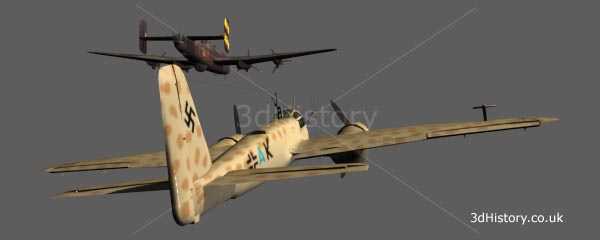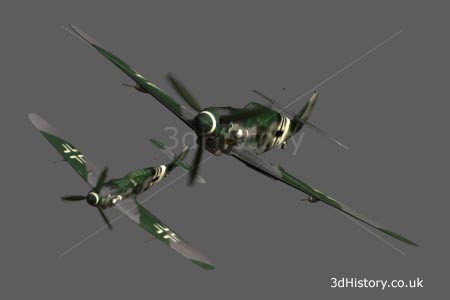The Second World War - Strategic Bombing - World War Two - War Machines
Strategic Bombing
Strategic Bombing was a concept developed by the Western Allies, America and Great Britain, to destroy the industrial capacity of Germany and Japan and prevent them from producing the means to wage war.
RAF Bomber Command attacked targets in Germany and occupied France as early as March 1940 but it wasn't until the new four engined bombers such as the Lancaster, Halifax and Sterling entered service in 1942 that it became possible to deliver a large concentration of explosives to an industrial complex or city deep inside enemy territory.

The Avro Lancaster was the RAF's principle heavy bomber. It was powered by four Rolls Royce Merlin engines, the same engine used by the Spitfire and Hurricane. It had a range of over 4,000 km and could carry up to 6,300 kg of bombs or a single Grand Slam bomb weighing nearly 10,000 kg. Specially modified Lancasters took part in the famous 'Dam Buster' raid in 1943 when aircraft from 617 Squadron used drum shaped 'bouncing' bombs to attack dams in the Ruhr valley in an attempt to disrupt industrial output there.
Attacking during the day was a very risky operation. Having no long range fighters to protect them meant that attacking bombers suffered very heavy casualties. The RAF recognised this very early on and switched from day to night bombing.
It was hard to identify targets when attacking at night. The Pathfinder force was created to locate targets and illuminate them using incendiary bombs so that the following waves of heavy bombers could see their targets.

The deHavilland Mosquito was made mostly from birch/balsa plywood that made it a relatively light aircraft. Its twin Merlin engines gave it a top speed of nearly 670 kph in level flight, faster than most of the fighters ranged against it. The Mosquito was used in several roles including: fighter, fighter bomber, bomber, torpedo bomber and reconnaissance.

The German Junkers Ju88-G was designed as a dedicated night fighter. It was fitted with radar so that it could identify and home in on enemy bombers in the dark. In addition to the forward firing machine guns it also had a gun mounted on the top of the fuselage that fired forward and upward into the underside of an enemy bomber.
Night fighters were developed specifically to combat the night bombers. These specialised aircraft used radar to be able to find their targets in the dark. They would be vectored to the target area by operators on the ground using a network of radar stations to locate the bomber formations.
The US Army Air Force based strategic air units in England with the task of attacking Germany's supply and production facilities, a similar mission to that of RAF Bomber Command. The USAAF chose to make its attacks during daylight using heavily armed B24 and B17 bombers.

The Boeing B17, otherwise known as the 'Flying Fortress', was the US Air force's main strategic bomber in Europe. It bristled with machine guns and was intended to fly in close formation with other B17's to provide maximum defensive firepower. Early missions over Germany suffered heavy casualties because of a lack of fighter cover.
Without adequate fighter cover the early missions suffered devastating casualties inflicted by fast single seat interceptors.

The Messerschmitt bf109G was a development of the basic bf109 having a more powerful engine, pressurised cockpit, new wing and a modular series of armament kits that included under wing mounted cannons and rockets. It was introduced in 1942 and along with the Focke- Wulf 190 it was responsible for challenging Allied air superiority over Europe and defending Germany from daytime bomber attacks.
Early Allied fighters were short range interceptors, such as the Spitfire and Hurricane, that had been designed for home defence. It wasn't until 1942 that an aircraft, the P51 Mustang, became available that was capable of escorting bombers all the way to their targets and back.

The North American P51 Mustang started life as a fighter bomber built to an RAF specification and powered by a n Allison V1710 engine. In 1942 the Mustang was fitted with a Merlin engine with a two-stage two-speed turbo charger that improved its maximum speed and altitude dramatically. It had an exceptionally range due to its very efficient laminar wing design. When wing mounted 340 litre fuel tanks were used it gave the Mustang the ability to escort bombers all the way to targets in Germany and back. Having an impressive maximum speed of nearly 750 kph meant that the Mustang could take on nearly all of the German fighters including the new jets.

The Messerschmitt Me262 was the world's first operational jet powered fighter aircraft. The design originated in the late 1930's but engine problems meant it didn't enter service until 1944. The jets were difficult to counter in the air so Allied tactics involved attacking them as they took off or landed.
The Germans used new technology, including jet and rocket powered aircraft, to attack the bombers. Despite being very effective in this role they were deployed in too few numbers to make any difference to the outcome of the war.
